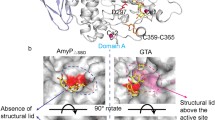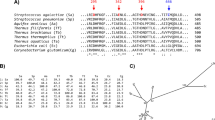Abstract
Some α-amylases besides catalyzing the hydrolysis of α-1,4 glycosidic bonds in starch are also capable of carrying out some transglycosylation activity. The importance of aromatic residues near the catalytic site in determining the ratio of these two competing activities has been remarked in the past. In the present work we investigated the role of residue 260 in the product profile of the α-amylase AmyA from Thermotoga maritima. This phenylalanine residue, two positions after the glutamic acid/base catalyst was substituted by both tryptophan and glycine residues, showing opposite behaviors. The tryptophan mutant displayed a very similar product profile pattern to that of the wild-type enzyme; while the mutant Phe260Gly showed a higher transglycosylation/hydrolysis ratio. When the Phe260Trp mutation was constructed in the context of His222Gln, a mutant we have already reported with an increased transglycosylation/hydrolysis ratio and a higher alcoholysis activity, the resultant enzyme showed an apparent higher hydrolysis/transglycosylation ratio and a change to shorter products pattern than the single mutant enzyme, still maintaining the increased alcoholytic activity provided by the His222Gln mutation. The mutant Phe260Gly, on the other hand showed by itself a higher alcoholytic activity, similar to that of the His222Gln mutant.
Similar content being viewed by others
Abbreviations
- AmyA:
-
α-amylase from Thermotoga maritima
- CGTase:
-
cyclodextrin glucanotransferase
- G1–G7:
-
oligosaccharides from G1 (glucose) through G7 (maltoheptaose)
- GH:
-
glycoside hydrolase
- HPLC:
-
high performance liquid chromatography
- TLC:
-
thin layer chromatography
References
Allen J.D. & Thoma J.A. 1976. Subsite mapping of enzymes. Application of the depolymerase computer model to two α-amylases. Biochem. J. 159: 121–132.
Brzozowski A.M. & Davies G.J. 1997. Structure of the Aspergillus oryzae α-amylase complexed with the inhibitor acarbose at 2.0 Å resolution. Biochemistry 36: 10837–10845.
Brzozowski A.M., Lawson D.M., Turkenburg J.P., Bisgaard-Frantzen H., Svendsen A., Borchert T.V., Dauter Z., Wilson K.S. & Davies G.J. 2000. Structural analysis of a chimeric bacterial α-amylase. High-resolution analysis of native and ligand complexes. Biochemistry 39: 9099–9107.
Crabb D.W. & Mitchinson C. 1997. Enzymes involved in the processing of starch to sugars. Trends Biotechnol. 15: 349–352.
Damian-Almazo J.Y., Moreno A., Lopez-Munguia A., Sobreron X., Gonzalez-Munoz F. & Saab-Rincon G. 2008. Enhancement of the alcoholytic activity of α-amylase AmyA from Thermotoga maritima MSB8 (DSM 3109) by site directed mutagenesis. Appl. Environ. Microbiol. 74: 5168–5177.
del-Rio G., Morett E. & Soberon X. 1997. Did cyclodextrin glycosyltransferases evolve from α-amylases? FEBS Lett. 416: 221–224.
Fogarty W.M. 1983. Microbial amylases, pp. 1–92. In: Fogarty W.M. (ed.), Microbial Enzymes and Biotechnology, Applied Science Publishers Ltd., New York.
Friedberg F. 1983. On the primary structure of amylases. FEBS Lett. 152: 139–140.
Janecek S., MacGregor E.A. & Svensson B. 1995. Characteristic differences in the primary structure allow discrimination of cyclodextrin glucanotransferases from α-amylases. Biochem. J. 305: 685–686.
Janecek S., Svensson B. & Henrissat B. 1997. Domain evolution in the α-amylase family. J. Mol. Evol. 45: 322–331.
Jespersen H.M., MacGregor E.A., Henrissat B., Sierks M.R. & Svensson B. 1993. Starch-and glycogen-debranching and branching enzymes: prediction of structural features of the catalytic (β/α)s-barrel domain and evolutionary relationship to other amylolytic enzymes. J. Prot. Chem. 12: 791–805.
Jorgensen S., Vorgias C.E. & Antranikian G. 1997. Cloning, sequencing, characterization, and expression of an extracellular α-amylase from the hyperthermophilic archaeon Pyrococcus furiosus in Escherichia coli and Bacillus subtilis. J. Biol. Chem. 272: 16335–16342.
Kim T.J., Kim M.J., Kim B.C., Kim J.C., Cheong T.K., Kim J.W. & Park K.H. 1999. Modes of action of acarbose hydrolysis and transglycosylation catalyzed by a thermostable maltogenic amylase, the gene for which was cloned from a Thermus strain. Appl. Environ. Microbiol. 65: 1644–1651.
Kim T.J., Park C.S., Cho H.Y., Cha S.S., Kim J.S., Lee S.B., Moon T.W., Kim J.W., Oh B.H. & Park K.H. 2000. Role of the glutamate 332 residue in the transglycosylation activity of Thermus maltogenic amylase. Biochemistry 39: 6773–6780.
Kondo H., Nakatani H., Matsuno R. & Hiromi K. 1980. Product distribution in amylase-catalyzed hydrolysis of amylose. Comparison of experimental results with theoretical predictions. J. Biochem. 87: 1053–1070.
Kuriki T., Kaneko H., Yanase M., Takata H., Shimada J., Handa S., Takada T., Umeyama H. & Okada S. 1996. Controlling substrate preference and transglycosylation activity of neopullulanase by manipulating steric constraint and hydrophobicity in active center. J. Biol. Chem. 271: 17321–17329.
Liebl W., Stemplinger I. & Ruile P. 1997. Properties and gene structure of the Thermotoga maritima α-amylase AmyA, a putative lipoprotein of a hyperthermophilic bacterium. J. Bacteriol. 179: 941–948.
Lim W.J., Park S.R., An C.L., Lee J.Y., Hong S.Y., Shin E.C., Kim E.J., Kim J.O., Kim H. & Yun H.D. 2003. Cloning and characterization of a thermostable intracellular α-amylase gene from the hyperthermophilic bacterium Thermotoga maritima MSB8. Res. Microbiol. 154: 681–687.
Matsui I., Yoneda S., Ishikawa K., Miyairi S., Fukui S., Umeyama H. & Honda K. 1994. Roles of the aromatic residues conserved in the active center of Saccharomycopsis α-amylase for transglycosylation and hydrolysis activity. Biochemistry 33: 451–458.
Mosi R., He S., Uitdehaag J., Dijkstra B.W. & Withers S.G. 1997. Trapping and characterization of the reaction intermediate in cyclodextrin glycosyltransferase by use of activated substrates and a mutant enzyme. Biochemistry 36: 9927–9934.
Nakajima R., Imanaka T. & Aiba S. 1986. Comparison of amino acid sequences of eleven different α-amylases. Appl. Microbiol. Biotechnol. 23: 355–360.
Pujadas G. & Palau J. 2001. Evolution of α-amylases: architectural features and key residues in the stabilization of the (β/α)8 scaffold. Mol. Biol. Evol. 18: 38–54.
Rey M.W., Brown K.M., Golightly E.J., Fuglsang C.C., Nielsen B.R., Hendriksen H.V., Butterworth A. & Xu F. 2003. Cloning, heterologous expression, and characterization of Thielavia terrestris glucoamylase. Appl. Biochem. Biotechnol. 111: 153–166.
Rivera M.H., Lopez-Munguia A., Soberon X. & Saab-Rincon G. 2003. α-Amylase from Bacillus licheniformis mutants near to the catalytic site: effects on hydrolytic and transglycosylation activity. Protein Eng. 16: 505–514.
Robyt J.F. & French D. 1967. Multiple attach hypothesis of α-amylase action: action of porcine pancreatic, human salivary, and Aspergillus oryzae α-amylases. Arch. Biochem. Biophys. 122: 8–16.
Rogers J.C. 1985. Conserved amino acid sequence domains in α-amylases from plants, mammals, and bacteria. Biochem. Biophys. Res. Comm. 128: 470–476.
Saab-Rincon G., del-Rio G., Santamaria R.I., Lopez-Munguia A. & Soberon X. 1999. Introducing transglycosylation activity in a liquefying α-amylase. FEBS Lett. 453: 100–106.
Sarkar G. & Sommer S.S. 1990. The “megaprimer” method of site-directed mutagenesis. Biotechniques 8: 404–407.
Suganuma T., Ohnishi M., Hiromi K. & Nagahama T. 1996. Elucidation of the subsite structure of bacterial saccharifying α-amylase and its mode of degradation of maltose. Carbohydr. Res. 282: 171–180.
Svensson B. 1988. Regional distant sequence homology between amylases, α-glucosidases and transglucanosylases. FEBS Lett. 230: 72–76.
Uitdehaag J.C.M., Mosi R., Kalk K.H., van der Veen B.A., Dijkhuizen L., Withers S.G. & Dijkstra B.W. 1999. X-ray structures along the reaction pathway of cyclodextrin glycosyltransferase elucidate catalysis in the α-amylase family. Nat. Struct. Biol. 6: 432–436.
van der Maarel M.J., van der Veen B., Uitdehaag J.C., Leemhuis H. & Dijkhuizen L. 2002. Properties and applications of starch-converting enzymes of the α-amylase family. J. Biotechnol. 94: 137–155.
van der Veen B.A., Leemhuis H., Kralj S., Uitdehaag J.C.M., Dijkstra B.W. & Dijkhuizen L. 2001. Hydrophobic amino acid residues in the acceptor binding site are main determinants for reaction mechanism and specificity of cyclodextringlycosyltransferase. J. Biol. Chem. 276: 44557–44562.
Vihinen M. & Mantsala P. 1989. Microbial amylolytic enzymes. Crit. Rev. Biochem. Mol. Biol. 24: 329–418.
Author information
Authors and Affiliations
Corresponding author
Rights and permissions
About this article
Cite this article
Damián-Almazo, J.Y., López-Munguía, A., Soberón-Mainero, X. et al. Role of the phenylalanine 260 residue in defining product profile and alcoholytic activity of the α-amylase AmyA from Thermotoga maritima . Biologia 63, 1035–1043 (2008). https://doi.org/10.2478/s11756-008-0170-4
Received:
Accepted:
Published:
Issue Date:
DOI: https://doi.org/10.2478/s11756-008-0170-4




